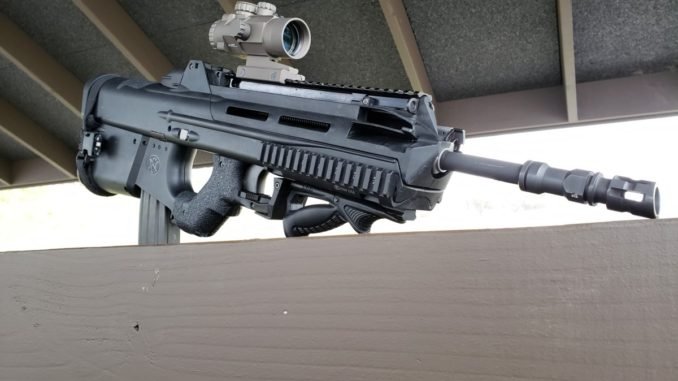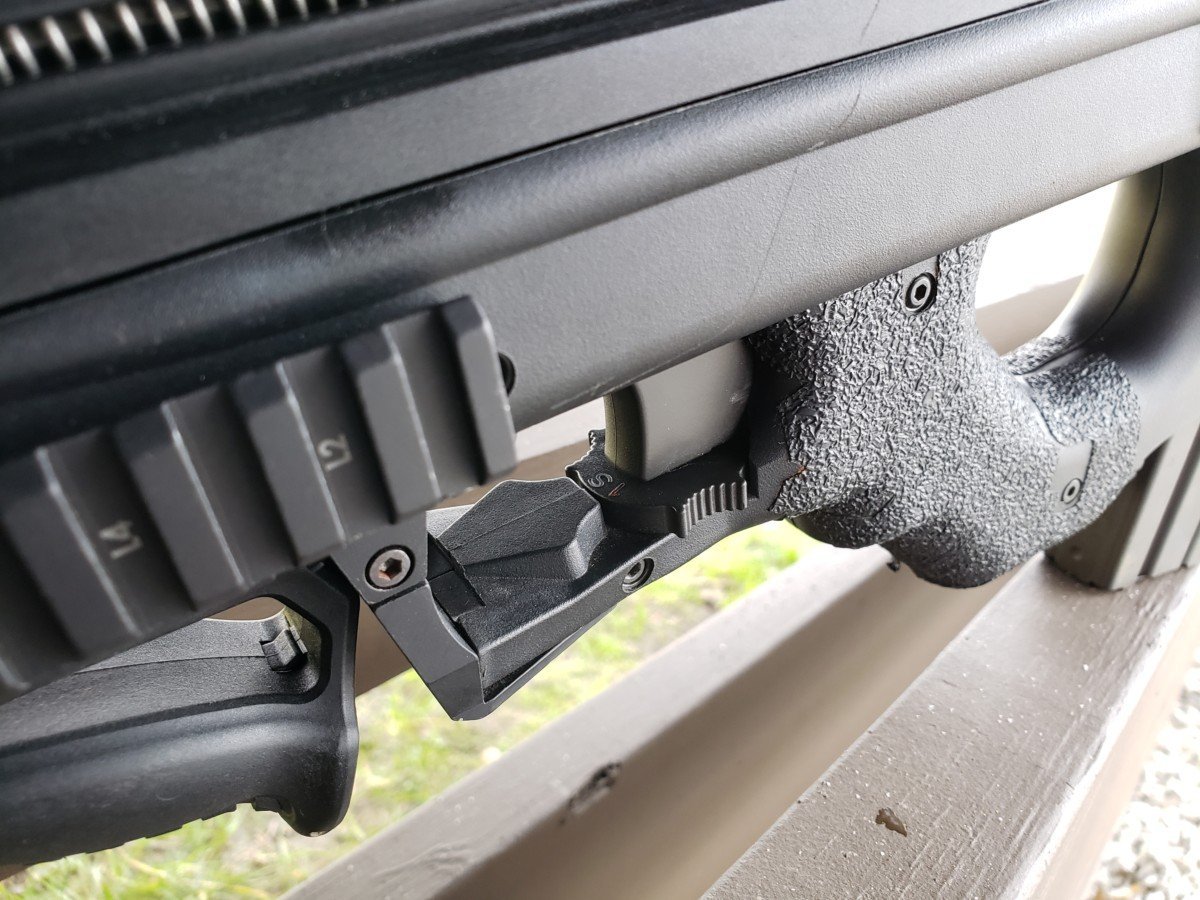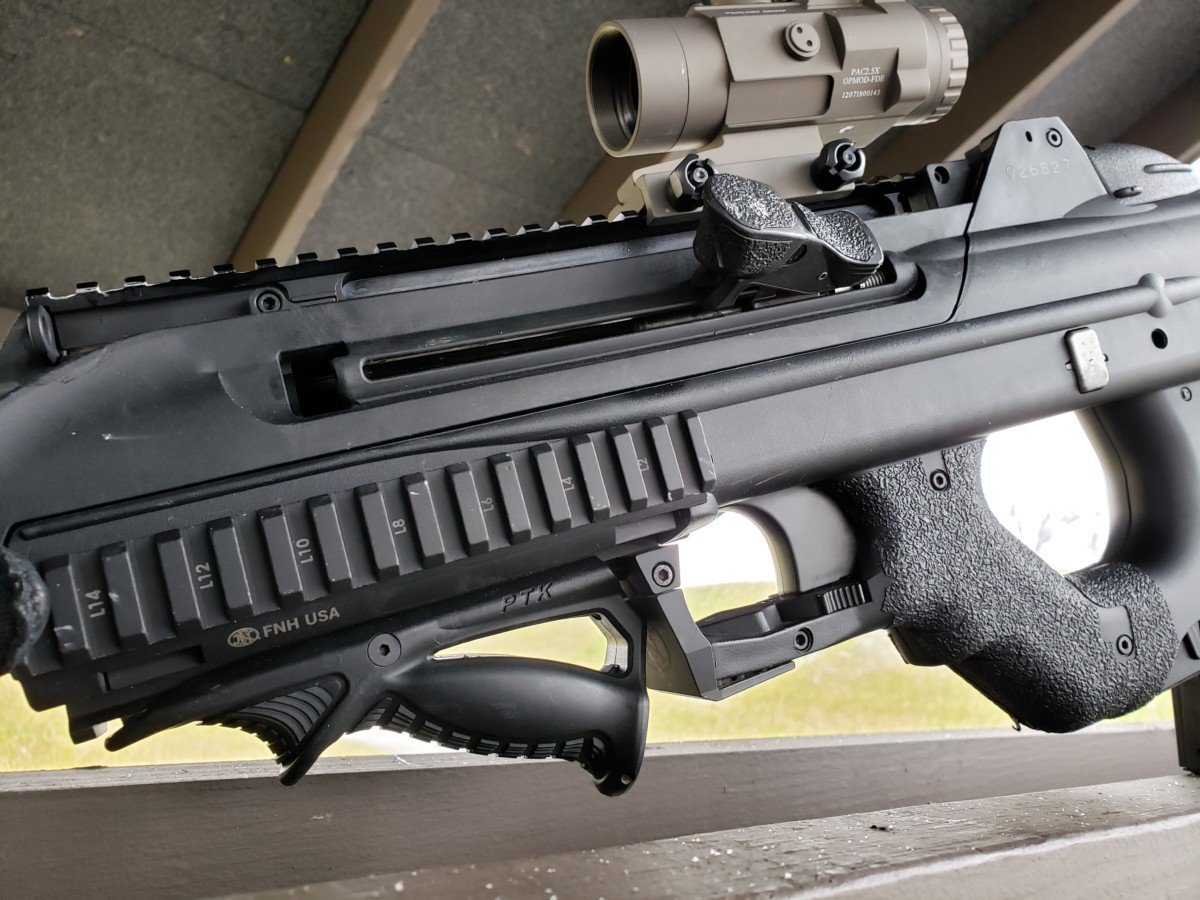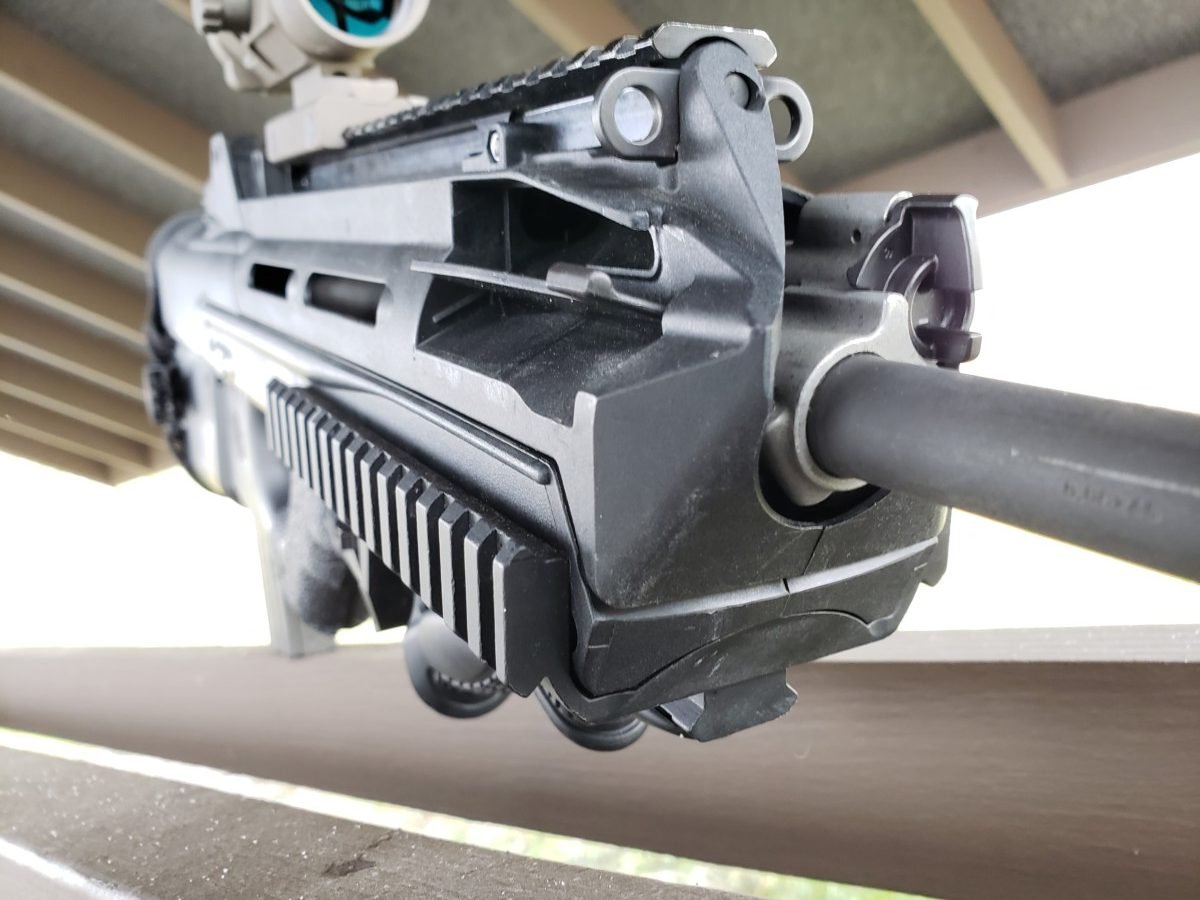
Bullpups, either you love them or you hate them. Full length barrels, at roughly half the length of a typical rifle, but at the cost of ergonomics and efficiency. The FS2000 is the civilian variant of FN’s F2000 assault rifle, one of the more modern bullpups on the market. I first learned of the gun in Battlefield 3 and used it for several months. Others have seen it in Splinter Cell, The Expendables, and more. How does this futuristic gun handle in real life?
The FS2000 is a piston driven, semiautomatic rifle chambered for 5.56×45 using standard STANAG pattern magazines. It features several modern designs such as ambidextrous controls, large usage of polymer, and picatinny rails for accessories.
Features and Ergonomics
One of the biggest negatives of the FS2000 is that shooters are limited to metal STANAG pattern magazines. Magpul PMags, Lancer L5AWM, and others will not fit into the rifle. This is due to the rubber O-ring like seal inside the magazine well. This is in place to help prevent the ingress of dirt and debris when a magazine is inserted, keeping the gun running clean. While STANAG magazines are cheap, reliable, and easy to find, most shooters I know consider this a deal killer.

Magazines do not drop free. The release is a large button that pushes upward, just in front of the magwell. Shooters must press this button upwards while grabbing the bottom of the magazine then pull the mag out of the gun. The rubber o-ring has some grip, so make sure to give a firm tug when releasing. The magwell is flared, aiding in rapid reloads. Magazines have an audible and tactile click when locked in place.
Ergonomics
The polymer chassis is completely smooth, with no texturing to enhance purchase on the gun. The example I used was covered in Talon Grip tape to help the owner keep a solid grip during adverse conditions. While I personally don’t like Talon Grips, they certainly help in this case.
The FS2000 is fairly comfortable to hold and operate. Length of pull is no issue for me, and proved to be fine for both taller and shorter shooters as well. The gun is well balanced in factory configuration, though we’ll touch more on that later. The grip is a bit fat, especially compared to a P90 or standard AR15 style grip. I can see this being an issue for shooters with smaller hands than mine.
I was not able to shoot with iron sights, as this specific example was missing the front sight. The rear sight is a small flip up peep sight that is integral to the gun.
Controls
The FS2000 trigger feels plastic-y with long take up, but a clean wall and fairly crisp break. Reset is short, very audible and tactile. The trigger has a very wide trigger face, which I think contributes to some of the issues shooters have. It’s certainly not as good as an AR15, but not nearly as bad as what I expected from a bullpup. I press triggers with the crook of my knuckle, which helped me to overcome the shortcomings of this example.

The safety is a rotating disk, located just below the trigger guard. The throw is fairly short, and it provides both audible and tactile indications of movement. For my hand size, I would prefer this disk to be slightly further forward, as I have to draw my finger slightly rearward to use it. The edges of the disk where you place your finger are a little sharp–not enough to hurt, but enough to notice and be unpleasant over time.
FS2000 features a left side charging handle similar to an MP5 or CETME. It is non-reciprocating, non-reversible, and does not lock open on empty. When changing magazines, shooters can either simply run the handle to charge the gun, or they can lock the gun open, and perform an HK Slap to get the rifle into action. The charging handle is articulated, and extends away from the gun slightly when pulled. This is an excellent detail, as it keeps your hands from smashing into optics and other devices hanging off the top rail.

Peeping Tom
On the right side of the gun is the ejection port. Rounds travel from the receiver down a semi-enclosed tube out the front of the gun. There is a trapdoor which snaps closed to prevent the ingress of debris into this channel. Shooters can keep the door closed when firing; once enough cases have been expended into the tube, the next round will force the trapdoor open, launching your brass several feet in front of you. This is especially impressive at indoor ranges.
With most rifles, you can easily look into the action via the ejection port on the side of the rifle. This is not so easy on the FS2000. Being a bullpup, everything is located behind the trigger, in the stock. The forward ejection mechanism means that there are no holes in the bottom or side of the gun like on a P90 or Tavor. How do you verify the status of the FS2000? Easy, you lift it’s skirt.

Just behind the rear sight is a small plastic door that hinges upwards. Once open, you can look directly at the chamber of the rifle to see action move. Closing this door does a surprisingly good job at keeping gas out of your face, even when firing rapidly.
Range Time with the FS2000
The rifle is currently on its second owner with roughly 700 rounds through it before I shot it for this article. All shooting has been mild range use, though this gun did experience a flood earlier in the year.
Rounds fired during my review:
- 20x SIG Sauer 40gr VPT
- 20x Federal 55gr JSP
- 20x Federal American Eagle M855 62gr FMJ
- 20x Hornady Critical Defense 73gr FTX
- 40x Hornady Frontier 62gr FMJ
- 160x PMC Bronze 55gr FMJ
The rifle was almost completely reliable throughout shooting. I experienced 1x light primer strike with Hornady Frontier, which did not fire after a second attempt. Range time was a mix of indoor shooting and outdoors in 20 degree weather with lots of snow. Two consecutive mag dumps made the FS2000 warm, but not unpleasant to hold.
During my first range trip the FS2000 was giving me quite a bit of recoil for a 5.56 rifle. Not so much as the Desert Tech MDR, but more than anything else. Upon closer inspection I realized the gas system was on the “adverse” setting, and promptly switched it to normal. This put recoil in line with virtually every other 5.56 rifle on the market.

My biggest issue with this gun is balance. Specifically balance with the addition of the aluminum tri-rail. Normally, the FS2000 features a slick foregrip, giving the gun a tuna or speedboat like appearance. This example features the FN tri-rail that replaces the factory foregrip. The ability to attach accessories such as weapon lights and grips is an awesome addition, but the rail ruins the balance of the gun, moving it far forward. Every shooter commented on this, and felt that it fatigued them much more quickly.
Final Thoughts
The FS2000 is an interesting note in bullpup history. No longer being imported to the US, the rifle is getting harder to come by every year. Generally running somewhere around $1,800 when you can find them, the FS2000 commands a premium, and will likely only continue to rise in price.
I would almost never recommend a bullpup to someone over a solid rifle in a standard configuration. That being said, if you are dead set on the type, you should probably look for something with more market support that is still being brought into the country. Still, the FS2000 is a unique rifle that works very well despite some interesting design features. I will never own one, but I appreciate friends that do, and would never deride them for their choice, as this is a good, but quirky, gun.
Support My Work
If you made it this far, thanks for reading! Writing isn’t my full-time profession, and nearly everything I do comes out of my own pocket. Between ammunition, tuition, range fees and more, expenses add up fast. If you like what I have to offer, consider making a donation to my Patreon.
Every bit helps bring more work like this to you, and contributes to shortened timelines or more in-depth work on my part. You’ll also have more direct access to me, offering suggestions for future projects, looking behind the scenes, and getting early access to some content. You can find my Patreon >>HERE<<


It’s a shame this gun didn’t catch on. Neither in America nor internationally. Only one nation adopted it and it was Slovenia’s Army.